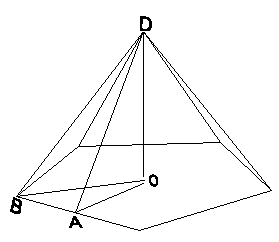What's the Volume of a Dodecahedron?

The picture above shows a dodecahedron. It's a solid body which has 12 perfect pentagons of the same size as its sides. I wondered what is the volume of such a body.
| What is the volume of a dodecahedron with an edge-length of a? |
The solution can be found some space below:
Solution:
Since a dodecahedron is a perfect solid with 12 identical sides at the same distance from its center, we can divide it into twelve identical pyramids. The corner of each pyramid is found at the dodecahedron's center, and the base is one of the sides.
The volume of a pyramid is the area of the base multiplied by its height divided by 3. We can calculate the height by the angle between the base and one of the surface sides. Since two pyramids are adjacent at every edge of the dodecahedron, we can find it by taking the angle between two adjacent sides of the dodecahedron and dividing it by 2.
To find that, let's take a corner of the dodecahedron, and form a triangle at the points which are at a certain distance along the edges. We get the following picture:

From point C, which is found somewhere along the edge, let's lower
two perpendiculars to the edge, down to the edges of the base
triangle. We get the triangle CAB. Now since the surface sides of
this pyramid are isoscles triangles, and the angle of a perfect
pentagon is equal to 180°*3/5=108 degrees, then the angle CDA
is equal to (180°-108°)/2=36° degrees.
Since angle ACD is a right angle, we find that CA (and CB) is equal to AD * sin(36°), and since the base triangle is perfect, AB is equal to AD. Thus, we know that AE/CA = AB/CA/2 = AD/CA/2 = 1 / (CA/AD) / 2 = 1 / (2 * sin(36°)). Thus, the angle ACE, which is half the angle between two sides of the dodecahedron and the angle we seek, is equal to arcsin(1/(2*sin(36°))). (approximately 58.28°).
Now, let's take the look at a side pyramid of a dodecahedron and calculate its volume:

Since the angle of a perfect pentagon is equal to 108°, angle
OBA which is half of it is equal to 54°. Since AB is
a/2, OA is equal to tan(54°)*a/2. Now, the base
of the pyramid is made of 5 equal triangles each of which has a
base of length a and a height of OA. Thus, the area of the
base is 5*(OA*a/2) = 5*tan(54°)*a/2*a/2 =
5/4*tan(54°)*a^2.
In the previous section we found out that the angle OAD is equal to arcsin(1/(2*sin(36°))), and therefore OD is OA * tan(arcsin(1/(2*sin(36°)))) = 1/2 * tan(54°) * tan(arcsin(1/(2*sin(36°)))) * a. The volume of the pyramid is the area of its base multiplied by its height (OD) divided by 3 and so it is equal to:
5/4 * tan(54°) * a^2 *
1/2 * tan(54°) * tan(arcsin(1/(2*sin(36°)))) * a
*
1/3 =
5/24 * tan(54°)^2 * tan(arcsin(1/(2*sin(36°)))) *
a^3
Since there are 12 such pyramids in a dodecahedron, its volume is equal to this volume multiplied by 12. Thus, we get that the volume of a dodecahedron is:
5/2 * tan(54°)^2 * tan(arcsin(1/(2*sin(36°)))) * a^3 = ~7.66 * a^3.










